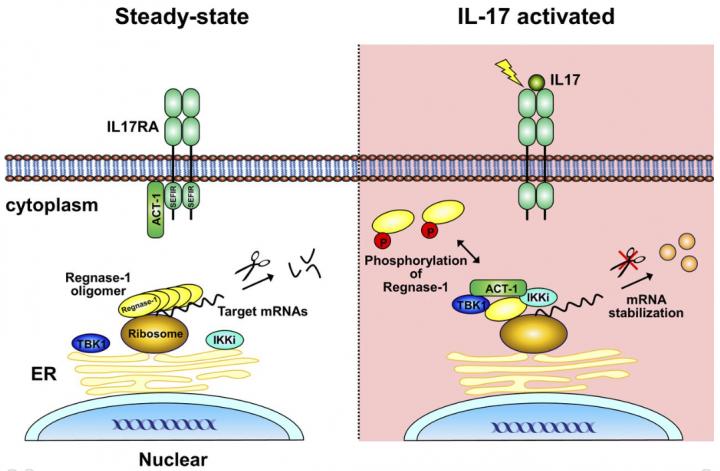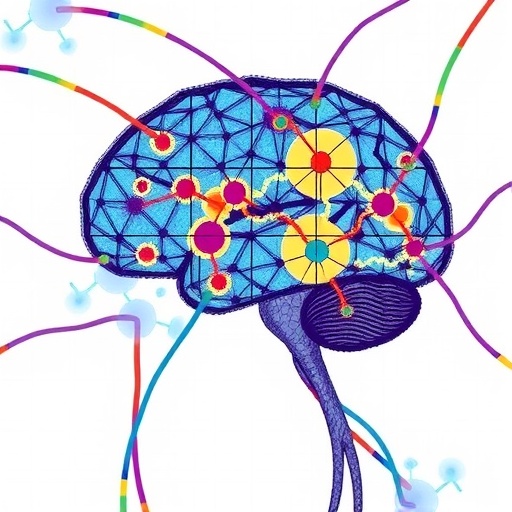A research team led by Osaka University finds that blocking the phosphorylation of mRNA-degrading enzyme Regnase-1 helps prevent excessive inflammation caused by unruly cytokine IL-17

Credit: Osaka University
Osaka, Japan – When considering the role of key immune molecule interleukin (IL)-17, the phrase “too much of a good thing” springs to mind. Because unlike some of its more sedate cytokine cousins, which studiously direct the immune response to destroy invading pathogens, IL-17 can get a little carried away. So much so that excess inflammation caused by IL-17 has been implicated in autoimmune disorders such as rheumatoid arthritis, psoriasis, and multiple sclerosis.
It is because of this destructive side of IL-17 that a research team led by Osaka University decided to examine exactly how mRNA-degrading protein Regnase-1 helps rein in the unruly cytokine. In an article published this month in the Journal of Experimental Medicine, the researchers describe how their results could provide some relief for patients suffering from IL-17-associated diseases.
Regnase-1 acts like a pair of scissors, chopping up inflammation-associated gene products so they can’t be expressed. By targeting genes turned on in response to inflammation, Regnase-1 prevents the body’s immune system from going haywire. However, through a process called phosphorylation, Regnase-1 is modified and thus its activity is abolished, allowing the expression of target genes. While external stimuli were known to activate this modification, previous studies had not determined exactly how phosphorylation occurs.
By altering or deleting Regnase-1 phosphorylation sites in mice, the researchers set about determining why phosphorylation was induced and how this process contributes to the regulation of IL-17-associated inflammation.
Interestingly, the researchers found that IL-17 can trigger the phosphorylation of Regnase-1, resulting in excessive inflammation.
Lead author of the study, Hiroki Tanaka, explains: “Using the mouse models, we showed that Regnase-1 is phosphorylated in response to IL-17 stimulation. The phosphorylated protein is expelled into the cytosol, where it can no longer interact with its target gene products.”
This loss of interaction means that the target genes are expressed, causing inflammation. However, the two mutant mouse lines showed a reduction in IL-17-induced inflammation, along with decreased disease severity in an experimental model of autoimmune encephalomyelitis.
“Our results confirm that phosphorylation of Regnase-1 plays an important role in the regulation of various inflammatory responses,” says senior author Shizuo Akira. “Based on these findings, we propose that Regnase-1 plays a critical role in the development of IL-17-mediated inflammatory diseases. This is exciting because it means that we may be able to design therapeutic agents that block the phosphorylation of Regnase-1, which may prove effective in the treatment of IL-17-associated autoimmunity.”
###
The article, “Phosphorylation-dependent Regnase-1 release from endoplasmic reticulum is critical in IL-17 response,” was published in the Journal of Experimental Medicine at DOI: 10.1084/jem.20181078
About Osaka University
Osaka University was founded in 1931 as one of the seven imperial universities of Japan and now has expanded to one of Japan’s leading comprehensive universities. The University has now embarked on open research revolution from a position as Japan’s most innovative university and among the most innovative institutions in the world according to Reuters 2015 Top 100 Innovative Universities and the Nature Index Innovation 2017. The university’s ability to innovate from the stage of fundamental research through the creation of useful technology with economic impact stems from its broad disciplinary spectrum.
Website: https:/
Media Contact
Saori Obayashi
[email protected]
Original Source
http://www.
Related Journal Article
http://dx.




